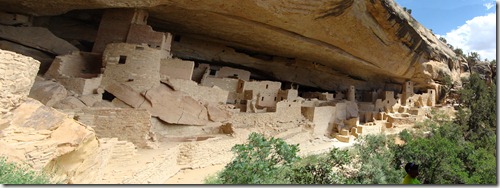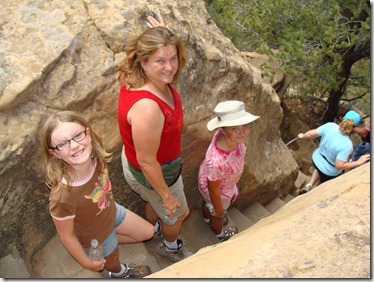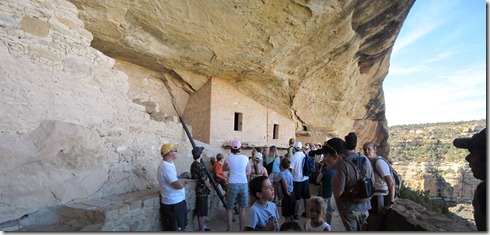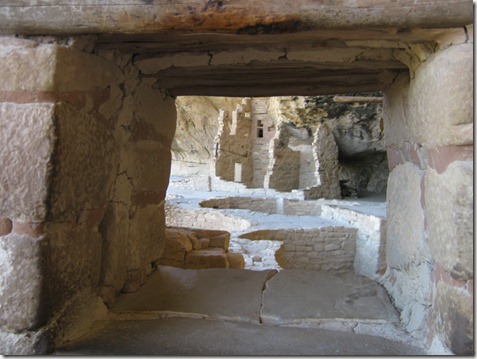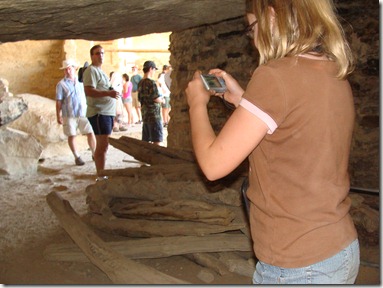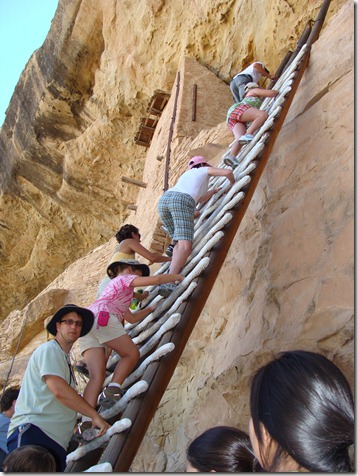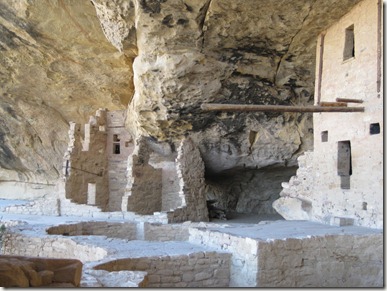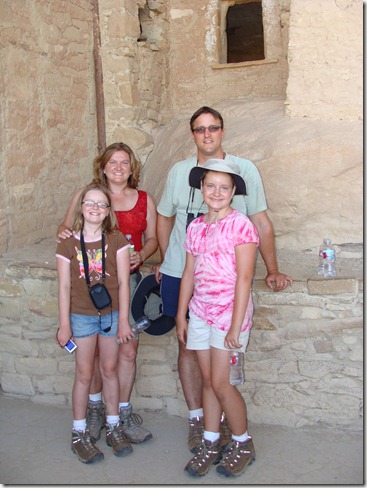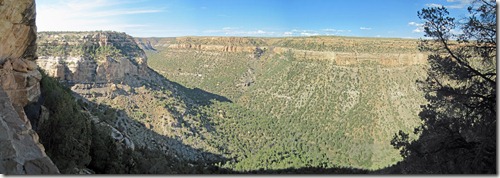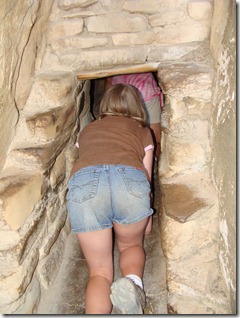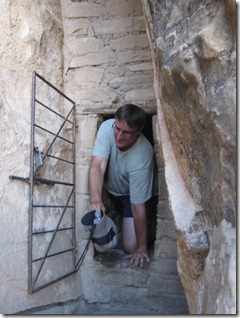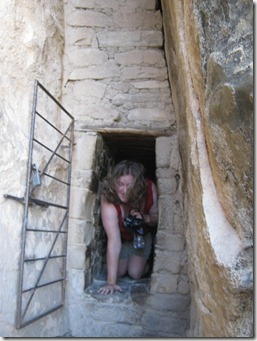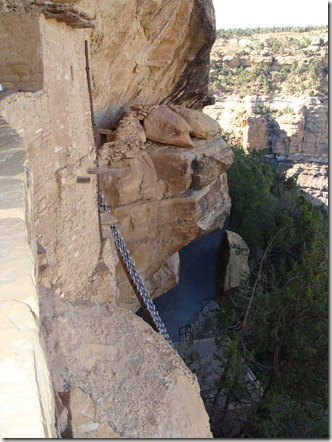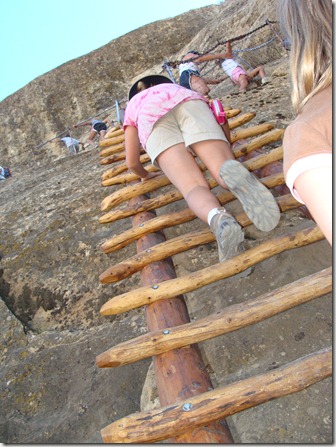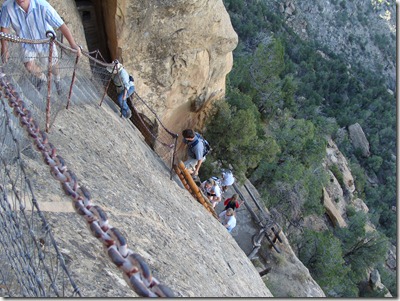Friday, July 16, 2010 (Mesa Verde)
The girls were really excited about today because they both did reports on Mesa Verde this year in school. They started out with more background about the history of the area and its people than Mike or I did. I can definitely say we learned a lot during the two tours we took today.
Mesa Verde is the site of what is left of more than 600 cliff dwellings once occupied by an ancient people once called Anasazi and now referred to as Ancestral Puebloans. “Anasazi” is a Navajo word meaning “enemy ancestors,” so the descendants of those people prefer a less aggressive name. (as a side note, I’m now going to have to rewatch an old X-Files episode titled “Anasazi” to see if the name conveys any meaning to the plot) Anyway, it was long known the people lived here for thousands of years along the top of the mesas growing food and hunting. At some point after 1100 AD, they moved their homes down from the mesas and into the rocky alcoves. By 1300 AD, they had completely left the area. European settlers didn’t stumble across the ruins of the cliff homes until the 1800’s when some cowboys looking for lost cows instead found Cliff Palace, the largest remaining cliff dwelling in the world.
Most of the cliff homes are small, inaccessible, or dangerous to explore. Several, though, are open to visitors. Three of the largest can only be seen with a guided tour. We had tickets for 3 tours and saw two of them today: Cliff Palace and Balcony House.
Cliff Palace was impressive because, at 122 rooms, it is the largest. The top half has fallen away, but you can still see the base of the structure and imagine what it would have looked like. Our ranger for this tour was a historian, so he spent most of his time focused on who the ancient people were, what their lives were like, and why they left the area. He explained that the cliff homes are built in sandstone that constantly seeps water. The largest homes have springs inside them. In an area where water was valuable, the cliff homes provided a constant source. He also linked water to the disappearance of the people. Research into the trees used to support part of the structures give evidence to a 20-25 year drought just before everyone packed up and left. If there was limited water and little food for that long, the common belief today is the people had to leave in order to survive.
More of Cliff Palace:
A first look at Cliff Palace: Originally, the stone rooms would have reached the top of the overhang
Walking the steps to access the Palace
What would have been a family area
Looking into a Kiva: When intact, a wooden roof covered this area so it could be walked on by those above. Inside the Kiva from below, the space was used by individual families for religious ceremonies and warmth during the cold months (that is a fire pit in the center)
We grabbed a late lunch near the museum before taking our tour of Balcony House. Balcony House is known for its difficult accessibility. Getting in requires a series of ladders and tunnels, and getting out requires more of the same with an additional climb along a rock ledge involving footholds and chains. Balcony House is also important because there is evidence it was once an open structure but was eventually reconfigured to provide a stronger defense. Again, the defense seems to surround the water source. The ranger for this tour wasn’t as quick to support the theory the cliff dwellers fought with one another for food and water, although she admits other possibilities remain a mystery.
Balcony House: Lots of walls and hard-to-get-to-spaces
For better defense, a wall and series of crawlspaces were constructed sometime just before people left the cliff dwellings
Julia snaps a picture of the remains of a Kiva wood roof from the year 1300
This was definitely our favorite tour so far because we could walk around inside the dwelling instead of just skirting the edges.
Climbing the ladder to reach the main area of Balcony House
The black marks on the ceiling are apparently from ancient cooking fires
A corn-grinding area. It is assumed that grinding corn with sandstone may have contributed to a shorter life span and most certainly contributed to grinding down the teeth of those who constantly ate corn meal containing bits of coarse sand
Looking out of Balcony House. There are several smaller cliff dwellings on the opposite mesa
Small openings make for a good defense Mike follows Julia through the tunnel
Not an easy crawl while carrying cameras and water bottles
A look at the ladder climbed to get in
Elizabeth starts the ladder climb to get out
A look back at the exit chains and ladders
We spent some time after the hike hanging out at Far View Lodge where we were told we could get internet service. No luck, though. It was just too slow. I’m not sure what their current system is, but their fiber optic cables were destroyed in 2000 when fire destroyed a huge section of the park. Two years later (I think), fire destroyed another section. Right now, more than 85% of the park is recovering from fire. Mesa Verde should be green on top according to its name, but that color is coming back slowly. The ranger pointed out a tree about 4 feet tall and said that because of the limited water in the area, these type of trees take a long time to grow. The 4 foot tall tree was estimated to be 100 years old. It will take hundreds of years for the park to be restored to full vegetation. Hopefully, it won’t take that long until somebody runs internet into the lodges and campgrounds again.

